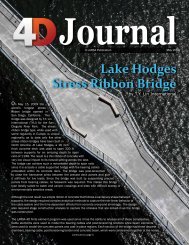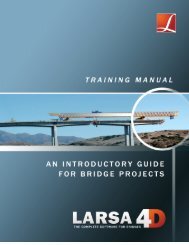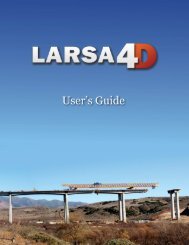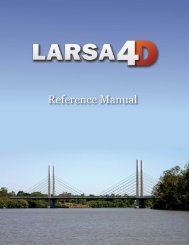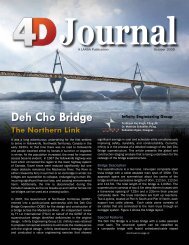A manual for - LARSA, Inc.
A manual for - LARSA, Inc.
A manual for - LARSA, Inc.
Create successful ePaper yourself
Turn your PDF publications into a flip-book with our unique Google optimized e-Paper software.
<strong>LARSA</strong> 4D Introductory Training Manual<br />
• “Properties” refer to the project input that defines the behavior of the elements in the model,<br />
including material properties, cross-sectional properties, nonlinear spring stiffness properties,<br />
and time-dependent material properties.<br />
• “Geometry” refers to the joints and elements that make up the structure.<br />
• “Joints” are connection points, or nodes, between elements. Joints have 6 degrees of freedom<br />
(DOF), three directions in translation and three in rotation.<br />
• “Members” are 2-node elements, including beams and beam-columns, cables and trusses.<br />
• “Springs” refer to spring elements used as 2-node springs and 1-node foundation springs. A<br />
spring can be linear elastic, nonlinear elastic or nonlinear inelastic.<br />
Basic Modeling Procedure<br />
<strong>LARSA</strong> 4D users normally follow these steps when creating a new model:<br />
• Set project units from Input Data → Units .<br />
• Import material properties from Input Data → Materials .<br />
• Import section properties from Input Data → Sections .<br />
• Create the geometry, either by drawing, using the spreadsheets ( Input Data → Geometry ),<br />
or the Model Data Explorer.<br />
• Create load cases and load combinations, either using the spreadsheets ( Input Data → Load<br />
Cases & Combinations ), or the Load Cases Explorer.<br />
• Running an analysis.<br />
• Inspecting results graphically and numerically ( Results → Spreadsheets ).<br />
The rest of this <strong>manual</strong> will illustrate these steps.<br />
8



